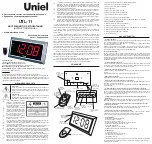
12
Digital clocks – NDC Series / User Manual v. 2.11
10
has
a dedicated address 1
, i.e. the Master is specified by setting that address. Master also secures the control
of the whole NDC-net. In the case of non-existence or availability of a synchronisation device, it also takes
over the time synchronisation.
Note: Even if just one NDC clock is interconnected with a synchronisation device (e.g. GPS), it has to be set
as the Master (i.e. address 1).
5.6.3 Network configuration {ConF}
({MEnu}→){SEt}→{ConF}
See a detailed description in a separate chapter 6.
INSTALLATION AND CONFIGURATION OF THE NDC-
net
.
5.6.4 Allocation of sensors, temperature display, address setting {S1Ad}, {S2Ad}
({MEnu}→){SEt}→{
S1Ad}
({MEnu}→){SEt}→{S2Ad}
An NDC-net may contain any number of sensors and NDC clocks (up to the maximum number of enabled
addreses). An NDC clock may display data from at maximum two sensors. By entering addresses {S1Ad} and
{S2Ad} you will specify from which sensor the data will be displayed. The data from a single sensor may be
displayed on a number of NDC clocks, notably on those that have its address in the items {S1Ad} or {S2Ad}.
If a local thermal sensor is connected and there is a requirement to display that temperature on the respective
clock, it is necessary to set the {S1Ad} or {S2Ad} address equal to the given clock (= {diAd}). So, for example,
if you want to display the local temperature on the clock with address “A005”, set the sensor’s address, {S1Ad}
or {S2Ad} on that clock to “A005”. If no sensor is connected, the display will display dashes (- - - - - -) on all
positions.
If you want to display a data from a remote sensor (if it is connected), it is necessary to set the adresss fo that
remote sensor. You can find the address in the list of devices in the network (see chapter
6.3 Viewing of the
list of devices {LiSt}
). So, if, for example, you want to display the temperature of a remote sensor whose
address is “A043” on the display, set the address of the sensor, {S1Ad} or {S2Ad}, on that clock to “A043”. If
the remote sensor with address “A043” is connected correctly, the clock will show its data, otherwise the text
{noSEnS}, (NDC xxx/6) or {noSE} (NDC xxx/4) will be shown, which means that there is no sensor with that
address in the network or there may be problems with the communication with that module.
If there is a synchronisation module with an integrated thermal sensor in the NDC-net and there is a
requirement to display its temperature data on some clocks, it is necessary to set the address of that sensor,
{S1Ad} or {S2Ad}, to „A127” on those clocks, since the address of the synchronisation module is fixed (“A127“).
The addresses of the rest of the modlules are configurable by DIP switches on them.
Note: For the future, it is counted with the development of sensor modules that will provide display data (e.g.
module providing details of temperature and humidity, temperature and atmospheric pressure...). If it is
necessary to display both details, for both parameters, {S1Ad} and {S2Ad}, it is necessary to set the
same address of the remote sensor. Figure 1 will be displayed in the display interval {S1PE} and Figure
2 in the display interval {S2PE}.
5.6.5 Allocation of the remote button, address setting {PbAd}
({MEnu}→){SEt}→{PbAd}
If it is necessary to control the stopwatch/counter from a remote location, it is possible to use the remote output
module. With that module it is then possible to control the stopwatch and counter functions within the range of
the NDC-net communication network.
With one remomote input module it is possible to control those stopwatches and counters running on different
NDC clocks that have its address set by item {PbAd}. In an NDC-net it is also possible to connect a number of
remote input modules and allocate them to individual clocks by means of the {PbAd} address.
5.6.6 Allocation of a remote input, address setting {roAd}
({MEnu}→){SEt}→{roAd}
In an NDC-net it is possible to connect a remote output module, which has one switching relay output and one
open collector output. These outputs can be controlled only by the Master clock (address “A001”). On the
master clock it is therefore necessary to set the address of the remote output {roAd} identical with the address
of the remote output module. The events at which outputs on a remote module are activated are identical with
the events at which the internal relay on the clock switches, i.e. when the counter limits are reached or when
the switching tooks place in the switching clock mode. The period of output module relay switch on state is
identical with the set switch on state of the internal relay set by {rLPE} or {rE0} – {rE15} in the {rEL} submenu.






































